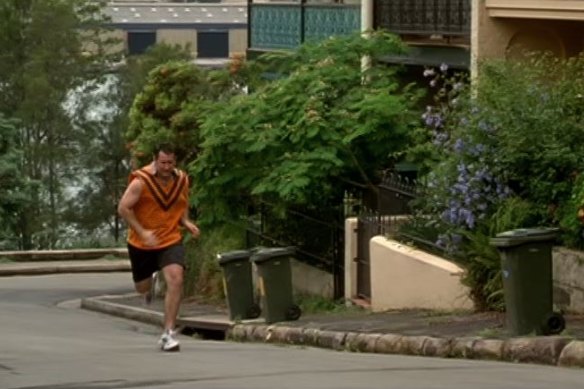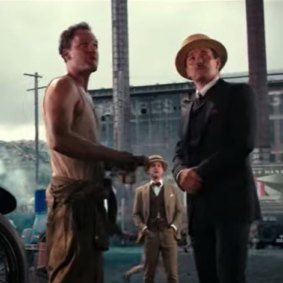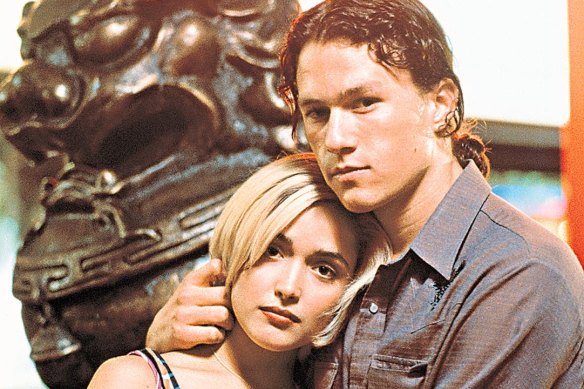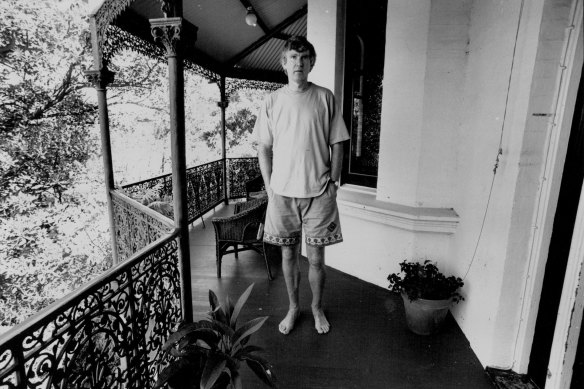This was published 9 months ago
Balmain is the pop culture mecca of Sydney. Here’s why
In our Sydney Scenes series, we ask writers to make the case for why their suburb is the best when it comes to pop culture. Up next, Balmain.
Venture with me on a walk in Balmain and I will offer a completely unsolicited catalogue of cultural references about this storied harbourside suburb in Sydney’s inner west. It is a compulsion. You can’t fight it. Just go with it.
There’s the spot in Balmain East near the water, populated with terraces, that Anthony LaPaglia, sporting a Balmain Tigers jersey, jogged past in the brooding 2001 film Lantana.

Anthony LaPaglia, playing detective Leon Zat, running up a Balmain East street in Lantana (2001).Credit: Jan Chapman Films Limited, Twentieth Century Fox
There’s the pub, police station and doctor’s surgery from iconic Australian soap opera E Street. Oh, you didn’t ask? Here’s my E Street oeuvre, published this year to coincide with the 35th anniversary of its premiere in the summer of ’89.
The 1996 film adaptation of Louis Nowra’s Cosi featured half the country’s leading actors – including Ben Mendelsohn, Barry Otto, Toni Collette and Rachel Griffiths – and made the most of filming locations in Balmain and the hauntingly beautiful, sprawling Callan Park in nearby Lilyfield.
Obviously, the long-running series Water Rats offered Balmain glimpses, and the real-life water police moved their headquarters to the neighbourhood in 2004.
The historic White Bay Power Station, then in disrepair and now with a multimillion-dollar restoration and a Biennale under its belt, stirred pride in the bosom of Balmainians in Baz Luhrmann’s The Great Gatsby (2013) as the backdrop to the dystopian Valley of Ashes. Sure, the hulking monument to industry is, in fact, in neighbouring Rozelle, but there’s not much in it.
Balmain is sometimes maligned as boring and stagnant, but typically only by those peering in from the outside. And, in the manner of the self-assured – think Mad Men’s Don Draper (“I don’t think about you at all”) – the locals don’t really mind.
The process of gentrification is undeniable and has sanitised much of the industrial grime of the once blue-collar stronghold. There’s an invitation-only graffiti wall, which is about as close to grunge as one gets. Former prime minister Paul Keating famously invoked the suburb in the 1980s when he derided the inner-city Labor Left as Balmain basket-weavers (“Then we’ll all live in renovated terraces in Balmain, and we’ll have the arts and crafts shops, and everything else is bad and evil”).
This was well before the Range Rovers and Bugaboos rolled in.

White Bay Power Station features in Baz Luhrmann’s The Great Gatsby (2013).Credit: Bazmark Film III Pty Limited
Keating got years of mileage out of his jibe. Writers at The Sydney Morning Herald weren’t spared his disapprobation in 1995. “There are Balmain basket-weaving lefties and Reaganite republicans,” he said of the “mixed grill” that comprised this newsroom’s workforce.
As it happens, Sydney Community College’s Rozelle campus does offer basket weaving courses, so the barb continues to have some bite.
Of course, Balmain has a spiritual significance for the Labor Party. The Unity Hall Hotel on Darling Street, one of the suburb’s many watering holes, has been called the birthplace of the ALP, but that is contested. Former premier Neville Wran, raised locally, uttered the immortal line: “Balmain boys don’t cry.” (They do now, surely, and probably at mortgage repayments). Fittingly, my best friend found a copy of Labor head-kicker Graham Richardson’s Whatever It Takes in a street library of sorts at Thames Street wharf.
And the late Tom Uren, a minister in the Whitlam Labor government and deputy leader of the party, is memorialised in a picturesque 2.3-kilometre walk around his birthplace known as the Tom Uren Trail. It starts and ends at Thornton Park, a sparkling harbourside jewel in Balmain East.
The neighbourhood has been a hotspot for authors, artists and actors for decades. Rose Byrne grew up here. Author Frank Moorhouse was a local. Acclaimed playwright David Williamson is a former Birchgrove resident (different name, same postcode).

Rose Byrne starred with the late Heath Ledger in the 1999 Australian film Two Hands.
But the real magic is in the mundane. This is a community bursting with ordinary stories.
“Where would you see such marvellous domestic architecture as you do in Balmain? The houses are squeezed among pubs, corner shops, disused factories … shipyards and metal works,” wrote Ruth Park, famed author of The Harp in the South and Playing Beatie Bow, in her book on Sydney.
Some of the stories are ugly. Balmain bears the scars of Indigenous dispossession – the traditional custodians of the land are the Gadigal and Wangal peoples of the Eora Nation – and heavy-handed industry.

David Williamson at his then-home in Birchgrove in 1993.Credit: Michele Mossop
There is an ongoing debate about housing density and the median price of a two-bedroom house is a scary $1.85 million. Not everyone here is a Richie Rich with harbour views, but the demographics are changing.
The best things about the suburb are shared. Later this year, the jacaranda at Propeller Park will burst back into bloom. Artists will set up their easels. Social media will be awash with purple.
And, one day, the film crews will be back. It’s a suburb with a big cultural footprint.
What do you think the best suburb in Sydney is for pop culture? Share your thoughts in the comments section.